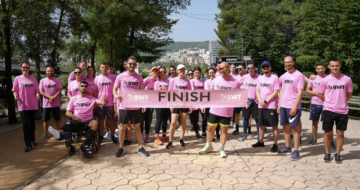The history of our Living Tomorrow project

An article by our founder Frank Beliën, on how the project once started, and what the future holds for Living Tomorrow.
An article by our founder Frank Beliën, on how the project once started, and what the future holds for Living Tomorrow.
An article by our founder Frank Beliën, on how the project once started, and what the future holds for Living Tomorrow.
In 1961, my father built his own house. As a young visionary architect, he created a modern prefab design, with an almost entirely glass exterior envelope. Inside were two core elements – bathroom and kitchen – around which the living areas were conceived. In 6 months’ time more than 300.000 people visited our home, as it became some sort of ‘open house’ for the public. I wasn’t born yet, so I have no idea how my parents managed that.
Fast forward to 1988. I was president of the architects student club Sopha, and we invited architects from all over the world to give seminars on our campus. That generated a lot of interest within the architecture community, and I am not ashamed to say that it benefited both my relationships with professors, and my grades. The same kind of entrepreneurship led our club to stay out of the red, unheard of, at the time!
Why do I mention these two anecdotes? Because they are characteristic of the road leading up to the start of Living Tomorrow in 1991: a combination of entrepreneurial spirit and drive for innovation. So how did it come about? At the time the House of the Future existed in Rosmalen (NL), created by TV-scientist Chriet Titulaer. After visiting, I was somewhat disappointed and wanted to do better. I was determined to raise the bar in terms of vision and innovation.
In order to realize my plan and the building, I needed financial backing, a terrain and a team. All were found pretty quickly. Hudevad signed off the first participant contract of many assuring the funds, we negotiated a site in Vilvoorde with its mayor and assembled a strong team of architects. But the project really took off when Joachim De Vos came onboard in 1993, and with him, the innovative power we needed.
Our search for support from companies, authorities and worldwide industry leaders culminated in Bill Gates opening the project in 1995. We even made the front page of the Wall Street Journal. Former prime minister Jean-Luc Dehaene was also fascinated by our project and proved a big help in securing support from the Flemish government. Later, Herman Van Rompuy, President em. European Council, Minister of State, took over as Chairman of the advisory board of Living Tomorrow.
Needless to say, we were extremely proud. Living Tomorrow was a resounding success. The level of innovation was truly unique at the time, really world class. We succeeded in creating a digital world, where the future could be experienced. Bill Gates making a documentary about it, proves that I am not just boasting idly. He became our ambassador to the world, so to speak.
157 companies joined the project, making us one the few successful autonomous and unsubsidised projects of its kind in Europe. We welcomed visitors from the four corners of the globe and went on to set up new projects in Vilvoorde, Amsterdam and Heusden-Zolder by 2000. The consultancy spinoff Tomorrowlab opened its doors in 2012.
So here we are today. It has been an incredible journey for me and the Living Tomorrow team to create the world of the future. At the very core is the team, always facing and dealing with new challenges. Continuously searching for innovation, partners and public around the world. We look forward with great enthusiasm and ambition to our next expansion and Living Tomorrow 2030.
I am more convinced than ever that we have the right people to do it.
Latest insights & stories

A Global Movement: The World Unites in a Pink Pledge for Clean and Sustainable Water
5,000 participants. 32 countries. €30,000 funds raised. And that's just the beginning.
Picture this: One step that sends ripples across the globe, transforming lives and creating waves of change. You might wonder, how can such a simple action for most of us have such a profound impact?

Sustainability and circularity in construction
Join us in transforming the future of construction, creating buildings that not only stand the test of time but also contribute to a healthier planet!

RainTunes: Shower scenarios for the soul
Light, hearing, smell, and touch: Together with experts, we have developed sensuous scenarios that turn showering into an individual experience. Whether you want to prepare for the day ahead or relax after working out. Whether you want to refresh after a day’s work or unwind at the end of the evening: RainTunes surprises with multisensory experiences.*
*Currently available only in Germany and Austria.